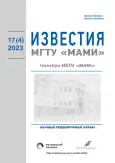Development of an algorithm for controlling the suspension of a heavy-duty vehicle using the technology of systems embedding
- Authors: Verkner A.S.1
-
Affiliations:
- MIREA – Russian Technological University
- Issue: Vol 17, No 4 (2023)
- Pages: 347-355
- Section: Hydraulic and pneumatic systems
- URL: https://journals.eco-vector.com/2074-0530/article/view/481502
- DOI: https://doi.org/10.17816/2074-0530-481502
- ID: 481502
Cite item
Abstract
BACKGROUND: The article is devoted to the development of an algorithm for controlling the suspension of a heavy-duty vehicle. The paper presents a suspension control system for a heavy-duty vehicle. The relevance is linked to the fact that by 2025, industry cooperation between representatives of the high-tech industry and scientists in the field of developing intelligent vehicle control systems is planned within the Autonet ecosystem. The control systems of modernized units with a high degree of electrification and digitalization are of the greatest interest to Russian automakers. This paper describes the results of a study of the active suspension of a heavy-duty vehicle from the side of control theory.
AIM: Development of an algorithm for controlling the suspension of a heavy-duty vehicle. A technical requirement for the monotony of the transition process was formed, since this is the main indicator of improvement of the operational properties of a vehicle, which becomes obvious especially clearly in the smoothness of the suspension.
METHODS: In the study, the fundamentals of the theory of automatic control, the theory of linear algebra, the concept of the state space, as well as methods of systems embedding based on modern achievements of algebra were used. Computer simulation was carried out in the environment of the MATLAB/Scilab/SimInTech kind.
RESULTS: A mathematical and computer model of a half of a four-point suspension of a heavy-duty vehicle has been developed. The paper presents a suspension control system for a heavy-duty vehicle. The control algorithm is developed using the systems nesting technology. The properties of the synthesized control system more than doubled the quality of the system compared to the characteristics of the control object.
CONCLUSION: The practical value lies in the ability of using the results of the study in the production and testing of adaptive suspension of a heavy-duty vehicle.
Full Text
About the authors
Alexey S. Verkner
MIREA – Russian Technological University
Author for correspondence.
Email: aleksverk@mail.ru
ORCID iD: 0000-0001-7269-4396
SPIN-code: 5575-7266
Postgraduate, Assistant at the Artificial Intelligence Institute Automatic Systems Department
Russian Federation, MoscowReferences
- Rajesh Rajamani. Vehicle Dynamics and Control. New York: Springer Science+Business Media; 2006.
- Asanov A.Z. Modeling and analysis of dynamic systems: Textbook. Naberezhnye Chelny: KamPI; 2004. (In Russ).
- Asanov A.Z. Technology of embedding systems and its applications to problems of analysis and synthesis of systems: a textbook. Moscow: MIREA — RTU; 2019. (In Russ).
- Bukov V.N. Nesting systems. Analytical approach to the analysis and synthesis of matrix systems. Kaluga: Izd-vo nauchn. lit. N.F. Bochkarevoy; 2006. (In Russ).
- Asanov A.Z. Canonization of matrices and its applications in control problems: Textbook. Moscow: MIREA — RTU; 2019. (In Russ).
Supplementary files

















